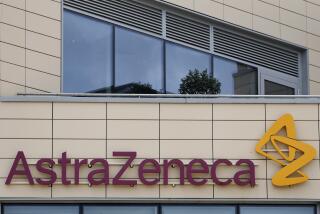2 New Programs to Offer Experimental AIDS Drug : Health: Maker of DDC will provide the medication along with AZT. Underground supplies have waned after FDA warning.
- Share via
WASHINGTON — At the request of the Food and Drug Administration, the drug company that produces the experimental AIDS drug DDC has established two programs to fill the void created by a lack of the medication on the underground market, FDA officials said Saturday.
Recently, the agency discovered that DDC being sold by illegal “buyers’ clubs” varied considerably in strength from the doses thought to be most effective and urged the clubs to discontinue selling the drug--which they are believed to have done.
FDA officials, who have exercised a hands-off attitude toward the illegal clubs, said they believed that some action was needed to replenish the supply for patients unable to obtain the drug, which is being developed by Hoffmann-LaRoche Inc., of Nutley, N.J.
The new programs will allow DDC to be given together with AZT, another antiviral AIDS drug, in a combination that limited studies show to have a more beneficial effect on the immune system than AZT alone.
“(Hoffmann-LaRoche) is committed to helping people in the AIDS community,” said Dr. Whaijen Soo, the company’s senior director of clinical virology and AIDS research. “These programs represent a dramatic step in providing access to a promising AIDS therapy. . . .”
The drug company already has a program of expanded access to the drug, but only for patients who take DDC alone because they cannot medically tolerate AZT.
In recent years, the FDA has relaxed its rules regarding the use of experimental AIDS drugs in order to allow individuals greater access to the medications while studies are conducted.
“We appreciate that the buyers’ clubs worked with us to maintain the good quality of the drugs they were selling, and we applaud Hoffmann-LaRoche for coming in to fulfill an important need,” FDA Commissioner David A. Kessler said Saturday.
Both programs will remain under a large-scale research umbrella, that is, information gleaned from them will be used by federal health officials to evaluate the drug. Hoffmann-LaRoche has already applied for marketing approval.
The first program, slated to begin within two weeks, will provide DDC to two different groups of individuals infected with the human immunodeficiency virus who wish to take the combination therapy.
These include those who already have experienced symptoms of disease and have CD4 cell counts of 300 or fewer, and those with CD4 counts of 200 or fewer who have not yet exhibited symptoms.
CD4 cells, also known as T helper cells, are the primary target of HIV, which causes AIDS. In healthy individuals, a normal CD4 count ranges between 800 and 1,200. As these critical immune system cells are destroyed, the body becomes prone to a range of life-threatening infections and other serious conditions.
DDC and AZT together have been shown, in small studies, to increase CD4 cells to higher levels and for longer periods of time than AZT alone.
The second program, a so-called “large simple trial,” will involve an estimated 10,000 to 15,000 healthier HIV-infected individuals--those with CD4 counts of up to 500. It will use AZT-DDC therapy but will compare different doses of DDC--a high dose versus a low dose.
This study will take a little longer to design and implement, FDA officials said. It also likely will involve input from the National Institutes of Health, which sponsors the most extensive network of research involving AIDS drugs.
“(Hoffmann-LaRoche) is looking for a partner in this study,” said Dr. David Feigal, director of the FDA’s division of antiviral drugs. “They have initiated conversations with NIH, but exactly who will do it remains to be seen.”
Feigal said the only individuals who might continue to have difficulty obtaining DDC are those with CD4 cell counts higher than 500 who want to take the combination therapy. Currently, AZT is recommended only for those with CD4 counts of 500 or fewer.
Until recently, most people taking DDC obtained the drug through the underground outlets. The buyers’ clubs have sprung up in recent years from the AIDS activist network as a source of both experimental drugs and approved medications.






